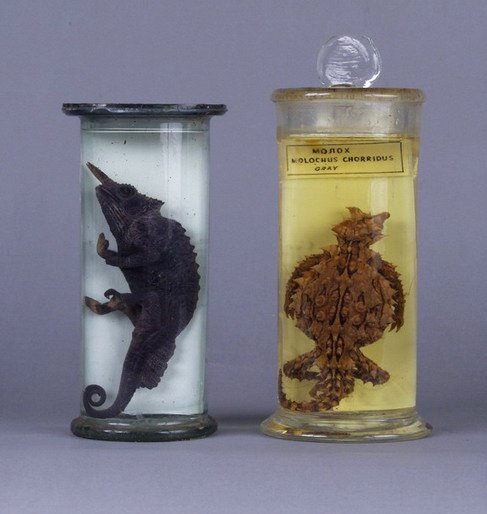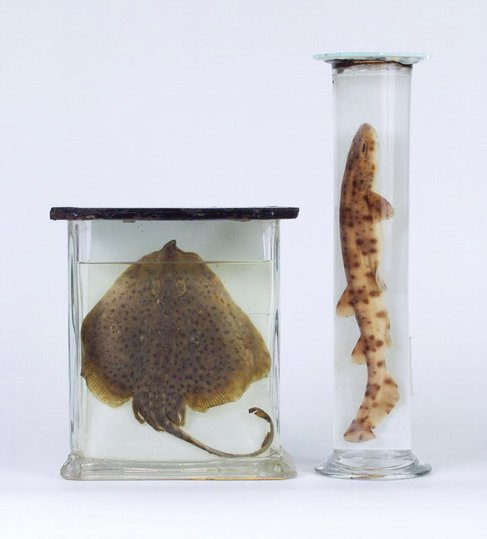2 148 fluid-preserved specimens. It was traditionally used as a raw material to replenish collections of taxidermied animals and other exhibits. The collection represents all classes of vertebrates and several systematic groups of mollusks, sponges, crustaceans, worms, and insects. It was formed according to the main idea of the museum – to highlight the main problems of evolution.
A significant number
of the specimens were purchased by Alexander Kohts from foreign trading
companies, such as Schluter (Germany), Fritsch (Austria-Hungary), Scheer
(Russia). In 1918, Professor Yury Belogolovy passed to Kohts a collection of
African Polypterus and some other fish, which he collected during the
expedition to the Congo and the Niger River basin, organized by the Moscow
Society of Naturalists in 1914. Some species were donated by Sc.D. Maria
Sadovnikova-Koltsova.
Among the vertebrate
specimens the most numerous are the amphibians, reptiles, and fish. The
specimens allow us to demonstrate the diversity of life forms in the kingdom Animalia,
including those interesting in terms of their external morphology, such as:
salamanders
and frogs (the olm, some species of newts, the salamander, the Mole salamander,
the common midwife toad, the common Suriname toad, tree frogs)
reptiles (the
thorny devil, some species of chameleons, various species of snakes)
a variety
of fish (Elasmobranchii, Lungfish, Polypteriformes).
The collection
contains almost all systematic groups of invertebrates, including:
Siboglinidae
Comb jellies (Ctenophora)
Cnidaria
Sponges
Echinoderm
Tunicate
Mollusca
various worms (including parasitic ones)
most arachnid and insect orders.
A number of the collection specimens allow to demonstrate the basic patterns of
individual development in insects (Hymenopterans, Diptera or flies). There are also
examples of rare species of tropical Myriapoda and Arachnida.
Worth to be noted is a
decent collection of various species of African fish collected in Ethiopia between
1986 and 1995, as well as botanical specimens, various species of sponges,
echinoderms, corals, fish, amphibians, and reptiles collected in Brazil,
Australia, the islands of New Guinea, New Caledonia, Fiji, New Hebrides, Lord
Howe Island, as well as the atolls Funafuti and Marakei between 1971 and 1983.
Valuable material on crustaceans (various types of crabs) in recent years was
brought from expeditions to Thailand and Malaysia (the Andaman Sea) by Darwin museum
employee Alexander Alyakrinsky.
Of great
scientific interest is the collection of bird embryos, comprising 218 specimens,
donated to the Museum. This collection of 22 species of different families
demonstrates species-specific features of embryogenesis.
The
collection of spirit brains of mammals deserves special attention. It contains
specimens of:
Marsupials
Pilosa
Eulipotyphla
Rodents
Lagomorphs
Carnivores
Pinnipeds
Cetaceans
Proboscidea
Tylopoda
even-toed ungulates and odd-toed
ungulates.
This collection, obtained from the Moscow Zoo, comprises 173 specimens.
Of particular interest
are the fluid-preserved newborns and young mammals of almost all the main
orders starting from marsupials and insectivores to pinnipeds and primates.
Some samples demonstrate examples of common individual development disorders,
such as abnormally developed calves.
Today, the collection
is completed by occasional collections by museum employees, as well as through donations
of raw materials from the Terrarium Center and the Moscow Zoo.

Chameleon (Chamaelio
sp.) on the left and the thorny devil (Molochus harrydius Gray) on the right.

The thornback ray (Raja clavata) and the catshark
(Sciliorhinus beshardi).









